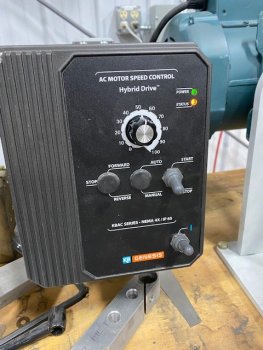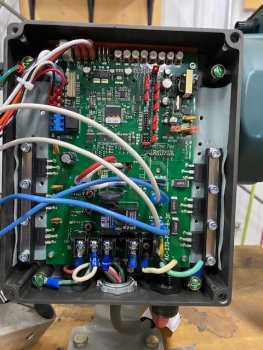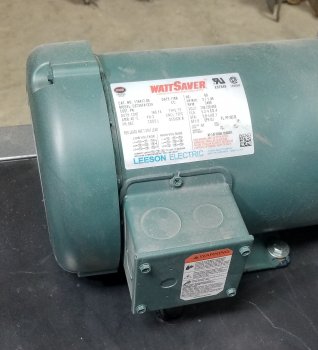These KBAC VFD speed controllers are pretty popular. They are called "drives".
These are used with 3 phase motors, which are cheaper than 1 phase and are found everywhere.
A VFD can take 1phase electric, like your house has and turns it into 3phase. It can also take in 3phase and work the motor but usually only commercial buildings have 3phase.
To control the speed, the drive adjusts the frequency of the electricity. There are DC motors that use varying voltage to control speed also. They are more expensive and when you drop the speed below half, they start to pulse and lose torque. VFD's maintain torque and smooth operating speeds across 90% of the speed range. When it gets to nearly 0 speed it acts up a bit but you wouldn't use it that slow anyway.
I have 5 VFD's in the shop. They are the bee's knees.
This particular one was brand new along with a new 3hp motor. It never worked right from day one. I worked around it and ignored it for some time.
I finally decided to get it fixed or replaced.
I called KBAC tech support and talked to Denise. She was positive and helpful and gave me some adjustments to try. It didn't work but I don't think it was her fault. The help script didn't cover this. It was a weird issue. My building is 3 phase with means my 30 amp circuits are 208v. I had a transformer put in to boost it to 240v across several outlets because the heat treat ovens didn't like 208v. I was convinced that was the problem. It wasn't.
I called back and we worked on it some more. She asked me to send in a video and she got the engineers to have a look and help troubleshoot. She pushed them for a resolution today, not tomorrow, next week. She gets it.

This is what the inside looks like. The red vertical things are jumpers that will change some things. Who knows what but apparently a lot of things. I'm sure some are for remote sensors and controls, voltage, frequency other than 60cycles, etc.
Along the very top you will see white circles. These are potentiometers that also adjust lot's of things.
These adjust with a little screwdriver. After a few attempts we did what the engineers said and the motor works perfectly now.
It seems the issue was the VFD (drive) was not properly synchronized with the motor and tweaking a couple settings got it all sync'd. The solution was to slow down the acceleration and deceleration of the VFD to better match what the motor was trying to do in response. We changed one other thing called COMP that does something also but I forget.
So, KBAC, great tech support and they have lot's of settings to work with to get your 3phase motor working. Recommended.
On a side note, when checking voltage across 240v leads make sure you have your multi meter set for AC and not DC voltage. The DC voltage setting creates a large arc with a blinding flash and a burnt up probe tip along with colorful profanity. It also causes Denise to laugh when she is on the phone as you do this.

These are used with 3 phase motors, which are cheaper than 1 phase and are found everywhere.
A VFD can take 1phase electric, like your house has and turns it into 3phase. It can also take in 3phase and work the motor but usually only commercial buildings have 3phase.
To control the speed, the drive adjusts the frequency of the electricity. There are DC motors that use varying voltage to control speed also. They are more expensive and when you drop the speed below half, they start to pulse and lose torque. VFD's maintain torque and smooth operating speeds across 90% of the speed range. When it gets to nearly 0 speed it acts up a bit but you wouldn't use it that slow anyway.
I have 5 VFD's in the shop. They are the bee's knees.
This particular one was brand new along with a new 3hp motor. It never worked right from day one. I worked around it and ignored it for some time.
I finally decided to get it fixed or replaced.
I called KBAC tech support and talked to Denise. She was positive and helpful and gave me some adjustments to try. It didn't work but I don't think it was her fault. The help script didn't cover this. It was a weird issue. My building is 3 phase with means my 30 amp circuits are 208v. I had a transformer put in to boost it to 240v across several outlets because the heat treat ovens didn't like 208v. I was convinced that was the problem. It wasn't.
I called back and we worked on it some more. She asked me to send in a video and she got the engineers to have a look and help troubleshoot. She pushed them for a resolution today, not tomorrow, next week. She gets it.

This is what the inside looks like. The red vertical things are jumpers that will change some things. Who knows what but apparently a lot of things. I'm sure some are for remote sensors and controls, voltage, frequency other than 60cycles, etc.
Along the very top you will see white circles. These are potentiometers that also adjust lot's of things.
These adjust with a little screwdriver. After a few attempts we did what the engineers said and the motor works perfectly now.
It seems the issue was the VFD (drive) was not properly synchronized with the motor and tweaking a couple settings got it all sync'd. The solution was to slow down the acceleration and deceleration of the VFD to better match what the motor was trying to do in response. We changed one other thing called COMP that does something also but I forget.
So, KBAC, great tech support and they have lot's of settings to work with to get your 3phase motor working. Recommended.
On a side note, when checking voltage across 240v leads make sure you have your multi meter set for AC and not DC voltage. The DC voltage setting creates a large arc with a blinding flash and a burnt up probe tip along with colorful profanity. It also causes Denise to laugh when she is on the phone as you do this.


